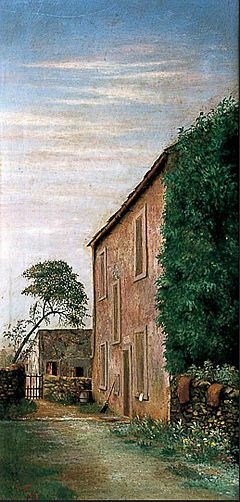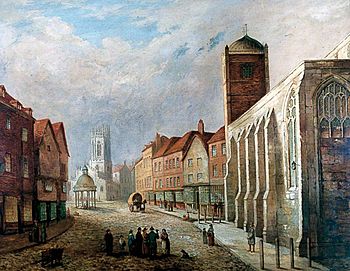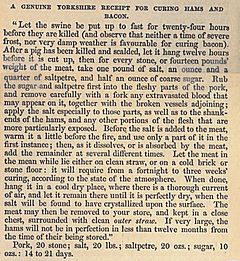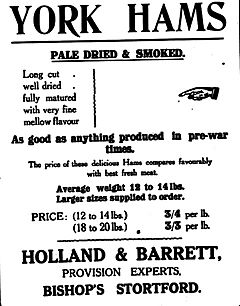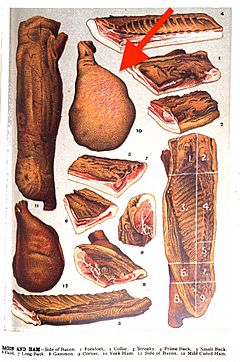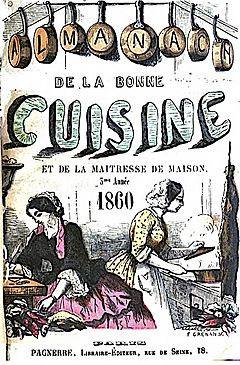York ham facts for kids
York ham is a special kind of ham that first came from Yorkshire, England. Unlike some other famous hams like Parma ham, York ham is made by a process called dry curing, but it is always eaten cooked. Many people think it's one of the best hams you can find.
Even though it's famous, York ham doesn't have a special legal protection like "protected designation of origin," which means other places can make and sell hams using the same name. Because of this, some hams sold as "York ham" might not be as good quality. It's also interesting to know that York hams didn't actually start in the City of York itself.

Contents
A Top-Rated Ham
Many famous chefs and food experts have praised York ham.
In his famous cookbook Le guide culinaire (1921), chef Auguste Escoffier said that while it was hard to pick the very best ham, York ham was excellent for eating cold. He also noted it was great when served hot.
Charles Elmé Francatelli, who used to be the chief cook for Queen Victoria, wrote in 1861 that York hams were "justly considered the choicest among English hams." He even thought they might be better than any other kind.
Cook's Encyclopedia (1980) by Tom Stobart says that York ham, "at its best, [is] regarded everywhere as the finest type of cooked ham."
Even a French online encyclopedia, Gastronomiac, calls York ham "an ornament of French gastronomy," even though it's from England.
How York Ham Started
Before refrigerators, people in the countryside would preserve meat, like hams from their pigs, to last through the winter. Different areas created their own ways of curing meat.
Records from 1166 show that Henry II of England got his hams from Yorkshire. By the mid-1700s, Yorkshire hams were well-known in London. People like Thomas Dyche and William Ellis wrote about how famous Yorkshire was for making and curing hams.
In 1796, Hannah Glasse wrote in The Art of Cookery Made Plain and Easy that Yorkshire was famous for hams because their salt was "much finer" and gave the meat a great taste.
Around 1760, newspapers started advertising "Yorkshire hams" and, a bit later, "York hams." By 1830, "York ham" became the more common name, but both terms meant the same thing. By the 1860s, "Jambon d'York" was even appearing on fancy menus in Paris, France.
When the Name Was Used Too Much
As famous products were sold far away, it became easier for some sellers to offer fake versions. This meant that names like "Yorkshire ham" started to be used for a certain style of curing, not just for hams from Yorkshire.
One writer in the late 1700s said that many "Yorkshire hams" sold in London were not actually from Yorkshire. Some were even Irish hams. A book from 1843, The Practical Cook, English and Foreign, warned readers that "a great proportion of the hams now sold as Yorkshire are Irish."
In Yorkshire, hams were usually made on farms. There weren't big ham factories there until much later. So, by 1898, many hams sold as "York" hams, especially in France, were actually made in big factories in Ireland. Some even came from America!
This meant that just seeing "York" or "Yorkshire" on a ham didn't guarantee it was high quality. You needed to trust the seller. This idea helped lead to modern branding, where a company's name guarantees quality.
What Makes a York Ham?
York ham doesn't have a special legal definition, so there's no single, agreed-upon way to describe it.
Over time, people have said a true York ham should have some specific features:
- It should come from the back leg (thigh) of a Large White pig.
- The pig should be raised and killed in Yorkshire.
- The ham should be dry-cured and aged on the bone using old methods.
- It should be shaped like a banjo.
- It should have very white fat and a mild, special flavor with light-colored meat.
However, today, very few hams meet all these points, and maybe they never did. "York ham" is mostly a style of ham.
Pig Breed
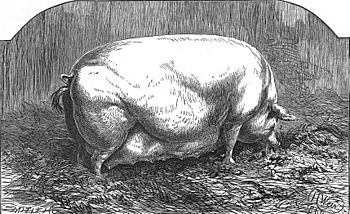
Many experts say that traditional York hams came from the Large White pig breed, also known as the Yorkshire Pig in America. This breed started in Yorkshire in the 1800s. Farmers in places like Leeds were very good at breeding pigs.
A weaver named Joseph Tulley created amazing pigs that became the basis for the Large White breed. These pigs became famous and were sold all over the world. By 1954, the Large White made up 76% of all male pigs in the UK. However, today, the Large White breed is considered at risk, with very few left.
Where It's Made

The connection between York ham and Yorkshire has changed over time.
In an 1877 court case, a supplier in Sheffield was sued for selling hams as "York hams" that were from Scottish pigs, even though they were fed, killed, and cured in Yorkshire. The judge and jury agreed they were proper York hams, saying that if all York hams had to be bred in the city of York, it would be "one vast piggery."
In 1897, a seller was fined for selling a Canadian ham as a York ham. A real Yorkshire ham cost much more.
In 1966, The Guardian newspaper reported that most York hams were made in a factory near Birmingham, not in Yorkshire. This factory, Marsh & Baxter, made four out of every five York hams and followed the traditional curing process.
Today, the Oxford Companion to Food (2014) says that "York ham" is the name of a curing method, and that "York hams" are made in other countries, not always as well as the original.
The City of York's Role
In the 1700s, the City of York was a big market town. Hams from the surrounding countryside were sent there and then shipped to London by boat on the River Ouse. This is likely why they were called "York" hams – because they were shipped from York.
Some stories claim York ham started in a specific butcher shop in York in 1861. However, by then, York hams were already famous in London and Paris. Earlier writers said the famous hams were made in the countryside of Yorkshire, not in the city itself. As Cook's Encyclopedia puts it, "York hams are not made in York — the cure is a popular one which is used all over the world."
How York Ham is Cured
Like Parma ham, York hams are made using a method called dry curing. This is an old farm method where dry salt is rubbed onto the meat to remove some of its water.
According to The Larder Chef, after curing, the ham is hung to dry in cool cellars for 3-4 months. During this time, a green mold might grow on the ham, especially near the bone. This mold actually helps the flavor and is washed off before cooking. This process is much slower than modern methods, which often use brine (saltwater) injections.
The companies that still make traditional York hams today use salt and saltpetre, but no added nitrites.
Is it Smoked?
Some people say York ham is smoked, while others say it's not. It's likely that original York hams were made in both smoked and unsmoked versions, depending on what people preferred.
For example, a recipe from 1847 by Eliza Acton didn't include smoking. But a magazine from 1839 said York hams were smoked in special smoking-houses using wood shavings and herbs. So, it seems both types existed.
Other Features
An experienced buyer in the 1877 court case described a York-fed ham as "plump, thick," with "very white" fat and an "unmistakable" flavor.
The Larder Chef also mentions that York ham has a "long cut" and a distinct "banjo shape." The "long cut" means the leg is removed from the pig by following the natural muscle lines, not just cutting straight across. This helps keep the ham from drying out during the long curing process.
Cooking York Ham
Unlike some other dry-cured hams, York ham is always cooked. It's usually boiled, and sometimes baked afterward.
English Cooking
In 1894, Alfred Suzanne wrote in Le Cuisine Anglaise that York ham was famous everywhere. He said the English usually cooked it simply: by boiling it in plenty of water without adding other flavors, because the ham was already flavored enough from the curing.
Before boiling, it should be soaked in water to remove extra salt. Then, it's wrapped in a cloth and simmered for about three hours.
If you want to eat it cold, you let it cool down before slicing. If you want it hot, you remove the skin and might bake it with sherry wine.
In Victorian times, it was common to serve hot York ham with Madeira sauce.
French Cooking
York ham was also used in fancy French cooking. Some dishes included:
- Jambon d'York à la gelée: York ham served in jelly.
- Dindonneau à la Royale: A dish with minced turkey, York ham, and other ingredients.
- Sandwichs au jambon d'York au beurre d'Isigny: Ham sandwiches with special French butter.
In Books
York ham has even appeared in famous books!
In John Galsworthy's A Modern Comedy, set in the 1880s, a character named Soames Forsyte is given "York ham with Madeira sauce" after winning a case.
In Marcel Proust's novel In Search of Lost Time, a character named Françoise mistakenly calls York ham "New York ham," which she pronounces "Nev'York." She would ask her kitchenmaid to get a ham from "Olida's," which was a real shop in Paris known for its York ham.



